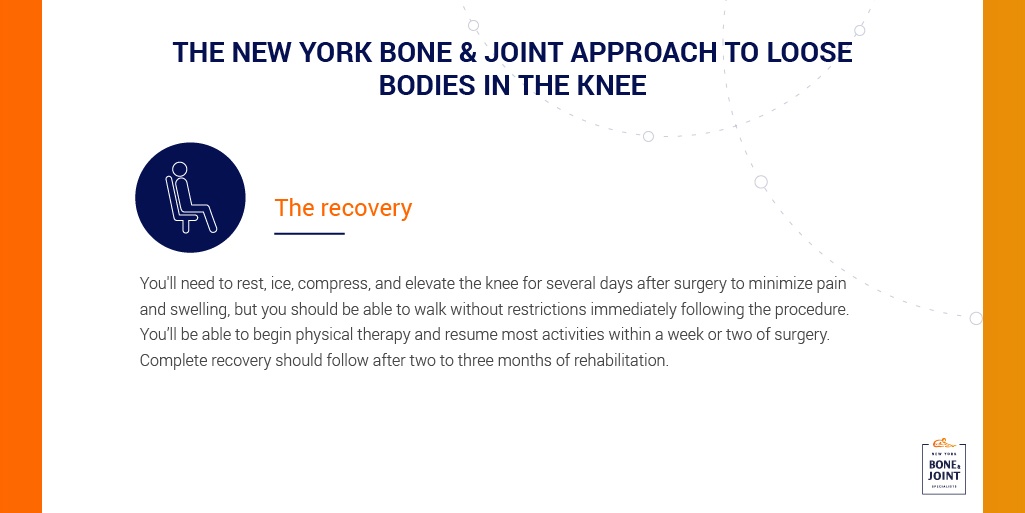WHAT IS A LOOSE BODY IN THE KNEE?
Loose bodies are generally pieces of bone and cartilage which become lodged in the synovium, the thin membrane lining a joint. These loose bodies can surface in any joint, but they’re most common in the shoulder and the knee. Generally resulting from a traumatic injury, these fragments can cause the knee to repeatedly catch and lock, preventing it from properly functioning and creating significant pain.
SYMPTOMS

Loose bodies in the knee may initially be asymptomatic, but in most cases, they cause moderate to severe pain in the joint. They also result in a catching or locking sensation when the patient attempts to flex or extend the knee. If left untreated, these bodies may gradually destabilize the joint, depriving it of its range of motion altogether.
TREATMENT
In some cases, loose bodies in the knee can be treated with anti-inflammatories and a physical therapy regimen designed to restore the patient’s range of motion. In general, however, they’re best treated with a short surgery, since loose bodies can make walking a challenge if left untouched.
SURGERY

Loose bodies in the knee can be removed with an arthroscopy. During this brief, minimally invasive procedure, your surgeon will view the joint through a small pinhole incision while operating on it through another opening. Over the course of surgery, your surgeon will extract the loose bodies and evaluate any damage to the cartilage before closing the incisions.
SURGERY RECOVERY

As a minimally invasive procedure, knee arthroscopy is designed to reduce the risk of complications and promote a quicker recovery. You will need to rest, ice, compress, and elevate the knee for several days after surgery to reduce pain and swelling, but most patients can walk out on the day of surgery without restrictions.
Your precise recovery timeline will depend on the extent of the procedure, but you’ll most likely be able to begin physical therapy immediately and resume normal activities within a week or two of surgery. You can expect a complete recovery after two to three months of rehabilitation.
FAQs: Loose Bodies in the Knee
What does it feel like when you have loose bodies in your knee?
For New Yorkers, the most noticeable symptoms of loose bodies in the knee start with severe pain when walking and restricted range of motion in the joint. This makes getting around the city difficult. Other symptoms include swelling and a grating sound in the knee when flexed known as crepitus. The knee may “lock up” and you may have a sensation of something moving in the joint. You can have more than one loose body in your knee.
Can loose bodies in the knee go away on their own?
No, loose bodies don’t go away on their own. If they present symptoms, the loose bodies require treatment to prevent further damage to the joint and possibly osteoarthritis. Conservative therapies such as anti-inflammatories and a physical therapy regimen designed to restore the patient’s range of motion can reduce pain and improve mobility in the joint. But even after conservative treatment the loose bodies may remain. So the only sure method to remove the loose bodies and the pain they cause is through a brief surgery.
How serious is loose body removal surgery?
Minimally invasive knee arthroscopy is the preferred surgery for removing loose bodies. During this short surgery, the surgeon makes pinhole incisions to remove the loose bodies. Because it’s done arthroscopically, the operation minimizes scarring and damage to nearby tissue and nerves.
How long does it take to recover from loose body removal surgery?
Knee arthroscopy recovery time is generally brief. In fact, most patients walk out the day of the surgery. For a few days after the procedure, you’re advised to rest, elevate your knee, and apply ice to the knee to reduce swelling. Physical therapy starts immediately after the surgery and you can return to your daily activities within a week or two. Complete recovery from loose body surgery can take two to three months with a rehab program.
What causes loose bodies to form in the knee?
Loose bodies in the knee are most often the result of a serious knee injury that dislodges a piece of cartilage. The trauma can be due to a sporting event, work, or simply stepping awkwardly off a city curb or subway step. Arthritis can also lead to a loose body in the knee.












